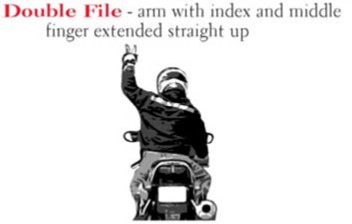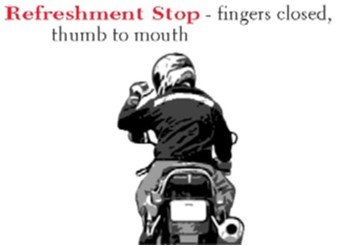Runs and Touring
From the Latin American Motorcycle Association International By-Laws, Article VII
Section 1: When participating on runs or rides, members should be on time. All members should be given a 30 minute grace period.
Section 2: All members should strive to leave together and return together on all activities.
Section 3: All driving should be done in “staggered twos" with the highest ranking officer in front or any other driver designated by the highest ranking officer.
Section 4: Members will ride in formation according to rank and then seniority. Passing will not be tolerated when riding in ranks.
Section 5: All members participating in a run or ride should have a full tank of gas before arriving at the starting point.
Section 6: All local traffic laws will be followed and respected.
Section 7: Know all hand signals so we can safely communicate when riding and make sure you telegraph them to riders behind you.
Section 8: Rest stops will be determined by the highest ranking officer present or a road captain. Runs or rides should not go any further than the distance necessary to refill the smallest tank on the trip. The highest ranking officer will decide the length of time of the rest stop.
Section 9: Road captains and other members should be certified in first aid and CPR and carry a trauma kit in case of an emergency.
Section 10: When inclement weather is evident, the road captain or highest ranking officer will determine a safe pull-off location to put on rain gear.
Riding Formation
The staggered riding formation (see diagram below) allows a proper space cushion between motorcycles so that each rider has enough time and space to maneuver and to react to hazards. The leader rides in the left third of the lane, while the next rider stays at least one second behind in the right third of the lane; the rest of the group follows the same pattern. A single-file formation with a minimum 2-second following distance is preferred on a curvy road, under conditions of poor visibility or poor road surfaces, entering/leaving highways, or other situations where an increased space cushion or maneuvering room is needed.
If a rider leaves during the ride, the rest of the group should re-form the staggered formation by criss-crossing into the next vacant position. Although it would seem more efficient for the column directly behind the missing rider to move up, we do not recommend it because passing another rider within a lane can be risky.
How to ride safely in a group.
Hand Signals
Group Riding Tips
Here are some tips to help ensure a fun and safe group ride:
Arrive prepared. Arrive on time with a full gas tank.
Hold a riders’ meeting. Discuss things like the route, rest and fuel stops, and hand signals. Assign a lead and sweep (tail) rider. Both should be experienced riders who are well-versed in group riding procedures. The leader should be aware of each rider's skill level before the ride and monitor the riders during the ride.
Keep the group to a manageable size, ideally five to seven riders. If necessary, break the group into smaller sub-groups, separated by a few seconds, each with a lead and sweep rider.
Ride prepared. At least one rider in each group should a first-aid kit and full tool kit, and all riders should carry a cell phone, so the group is prepared for any problem that they might encounter.
Avoid side-by-side formations, as they reduce the space cushion. If you suddenly needed to swerve to avoid a hazard, you would not have room to do so. You don’t want handlebars to get entangled.
Periodically check the riders following using your rear view mirrors. If you see a rider falling behind, slow down so they may catch up. If all the riders in the group use this procedure, the group should be able to maintain a fairly steady speed without pressure to ride too fast to catch up.
If you’re separated from the group, don’t panic. Your group should have a pre-planned procedure in place to regroup. Don’t break the law or ride beyond your skills to catch up.
For mechanical or medical problems, use a cell phone to call for assistance as the situation warrants.
Uniforms
From the Latin American Motorcycle Association International By-Laws, Article XXI
Section 1: The L.A.M.A. uniform is composed of black boots, denim blue jeans, black t-shirt and a black leather vest. In tropical countries an ash grey t-shirt (not in the USA) can be substituted but the whole chapter must be in the same uniform.
“The highways are crowded with people who drive as if their sole purpose in getting behind the wheel is to avenge every wrong done them by man, beast or fate. The only thing that keeps them in line is their fear of death, jail and lawsuits.”

















